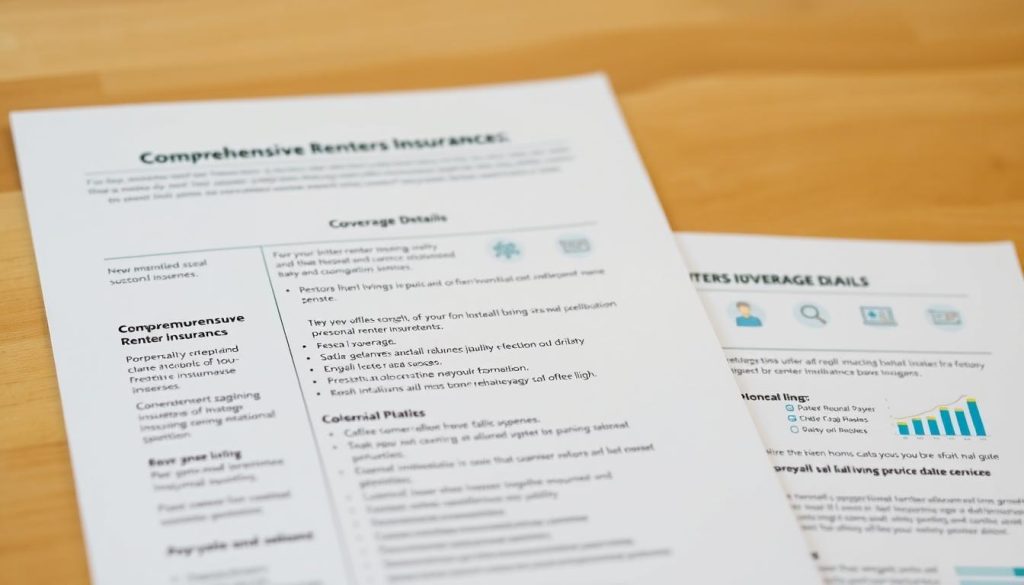Renters Insurance Coverage: What’s Included and Why You Need It
Living in a rented space brings freedom, but unexpected events can turn that freedom into financial stress. A smart solution exists to safeguard your belongings and legal interests without breaking the bank. This protection typically costs less than $30 monthly – cheaper than most gym memberships or streaming bundles.
Landlords handle structural repairs, but you are responsible for your personal items. Imagine replacing furniture, electronics, or clothing after theft or fire damage. Industry data shows the average policyholder protects over $24,000 worth of possessions through their plan.
Legal liability represents another crucial aspect. If someone gets injured in your home or you accidentally damage property, this financial safety net helps cover medical bills or repair costs. Many people underestimate these risks until they face expensive lawsuits.
Key Takeaways
- Standard policies shield personal items from theft, fire, and water damage
- Includes liability protection for accidents involving guests
- Average monthly costs range between $15-$27 nationwide
- Doesn’t cover the building structure – only your possessions
- Offers financial security comparable to homeowners’ plans
Understanding Renters Insurance Coverage
Your landlord’s safeguards stop at the walls—what about everything inside them? Tenant agreements focus on structural upkeep, leaving personal assets vulnerable. A specialized safety net bridges this gap through three core shields: belongings replacement, accident liability, and temporary housing costs.
How Protection Plans Work
These agreements operate through reimbursement systems. When disasters like theft or fires occur, policyholders submit proof of loss to their provider. Compensation follows after deducting agreed-upon amounts, capped at specified limits. Most plans include:
- Replacement costs for electronics, furniture, and clothing
- Legal support if guests get injured on your premises
- Hotel stays during property repairs
Tenant vs. Property Owner Safeguards
Property owners maintain policies for permanent structures—walls, plumbing, and shared spaces. Their financial responsibility ends where personal possessions begin. This table clarifies the division:
| Protection Type | Tenant Plan | Owner Plan |
|---|---|---|
| Personal Electronics | Full replacement | Not covered |
| Burst Pipe Damage | Belongings only | Wall repairs |
| Visitor Injuries | Medical bills | Common areas only |
Smart tenants combine their plan with the property owner’s safeguards. This layered approach ensures complete protection for both parties’ interests.
Key Benefits of Renters Insurance Coverage
When disaster strikes your leased home, two powerful safeguards spring into action. These protections address both material losses and legal risks, creating a safety net that shields your finances from unexpected setbacks.
Financial Reimbursement for Personal Property
Your personal belongings gain protection against 16 common risks, including fires and theft. Policies typically cover items anywhere in the world—a stolen laptop from your car qualifies like one taken from your living room. Replacement calculations vary:
- New equivalent items (replacement cost)
- Depreciated value (actual cash value)
Windstorms destroyed a tenant’s patio furniture last year. Their renters’ insurance policy paid $2,300 for brand-new replacements—no deduction for previous wear.
Liability Protection and Legal Defense
Accidental property damages or guest injuries trigger this critical shield. A spilled drink ruining a neighbor’s antique rug? Your plan handles repair costs. Slip-and-fall incidents could lead to medical bills exceeding $20,000—far beyond most savings accounts.
“Liability claims often surprise tenants until they review their policy details. The average dog bite settlement reaches $50,000 nationally.”
Standard liability coverage includes attorney fees and court expenses if lawsuits arise. Higher protection tiers prove valuable for pet owners or frequent hosts.
What Renters Insurance Policy Covers

Unexpected disasters don’t discriminate between homeowners and tenants—they strike wherever vulnerability exists. Modern safeguards address three critical areas to keep your life on track during crises.
Guarding Your Possessions
Personal property shields apply to items damaged by 16 common risks. Furniture, electronics, and clothing qualify whether stored at home or temporarily elsewhere. A stolen bicycle from your workplace parking lot receives the same protection as one taken from your apartment.
Covered events include:
- Weather-related damage (windstorms, hail)
- Theft attempts and vandalism
- Water leaks from appliances
When Temporary Housing Becomes Essential
Catastrophes like fires often force residents out during repairs. This benefit covers:
- Hotel stays exceeding normal rent costs
- Restaurant meals when the kitchens become unusable
- Laundry services during displacement
A family displaced by smoke damage last winter received $4,200 for two weeks’ lodging and meals through their plan.
Legal Shields Beyond Basic Protections
Accidental incidents trigger this critical support. Spilled drinks ruining a landlord’s hardwood floors? Your plan handles restoration costs. Most policies also include:
- Court fee reimbursements up to $50,000
- Medical payments for injured delivery personnel
- Fire department service charges during emergencies
“Tenants often discover hidden benefits like food spoilage coverage during power outages, a lifesaver for those with full freezers.”
Policy Details and Limitations
Protection plans set clear boundaries through financial caps and category restrictions. These parameters determine what gets replaced and how much you’ll receive when filing claims.

Coverage Limits and Sub-Limits
Every agreement specifies maximum payout amounts. A $25,000 plan might cover furniture replacement after a fire, but only pay $1,500 for stolen diamond earrings due to jewelry sub-limits. High-value categories often have stricter caps:
- Business equipment: $2,500 maximum
- Collectibles: $1,000 per item
- Watercraft: $500 total
Special rules apply to cash, firearms, and luxury goods. A stolen designer handbag worth $3,000 might only qualify for $800 reimbursement under standard terms. Always review category-specific restrictions before assuming full protection.
Natural disasters like earthquakes and floods require separate policies. Standard agreements exclude:
- Rodent damage to electronics
- Mold from unresolved leaks
- Intentional property destruction
“Last year, 43% of claimants discovered their water-damaged antiques weren’t fully covered due to sub-limits,” notes insurance analyst Mara Whitman.
Upgraded endorsements solve these gaps for valuable collections. Document appraisals help secure appropriate protection levels for rare items exceeding standard caps.
Determining the Right Coverage for Your Needs
How much protection do your household items really need? Start by walking through each room with a critical eye. Every lamp, gadget, and wardrobe choice contributes to your financial safety net.
Assessing the Value of Your Belongings
Create a detailed inventory using your smartphone or notebook. Focus on high-ticket items first—electronics, furniture, and appliances. Then move to smaller possessions like cookware and decor. Follow this process:
- Photograph each room from multiple angles
- Check manufacturer websites for current prices
- Note serial numbers for tech devices
- Scan storage areas for seasonal gear
Update your list after major life events. New purchases or relocations often change protection requirements. A recent survey showed 68% of tenants underestimate their belongings’ total value by $10,000+.
Understanding Policy Terms and Exclusions
Policies use specific language that impacts reimbursement amounts. “Replacement cost” means new equivalents, while “actual cash value” deducts depreciation. Consider this comparison:
| Term | Payout Example |
|---|---|
| Replacement Cost | $1,200 for new sofa |
| Actual Cash Value | $400 for 5-year-old sofa |
Review limitations on collectibles and electronics. Most plans exclude damage from pests or gradual leaks. Always verify what natural disasters your agreement includes—many require separate riders.
“Digital inventories simplify claims but physical copies prevent tech failures from erasing proof,” advises asset protection specialist Lisa Corrente.
Store documentation in multiple secure locations. Cloud storage and fireproof boxes ensure access during emergencies. Annual reviews with your provider keep protection aligned with changing needs.
Ways to Save on Your Renters Insurance Policy
Smart financial planning turns essential safeguards into budget-friendly solutions. Strategic adjustments and proactive measures can significantly reduce expenses while maintaining robust protection.
Bundling Options and Discount Strategies
Combining policies with the same provider often unlocks multi-policy discounts. Many carriers offer 10-25% savings when pairing auto and tenant plans. Electronic billing and automatic payments typically shave 3-5% off premiums through reduced administrative costs.
Group discounts through employers or professional organizations provide additional opportunities. Loyalty rewards and claims-free histories further lower rates over time. Always ask your agent about available reductions during policy reviews.
Installing Safety Devices and Adjusting Deductibles
Smoke detectors and security systems frequently qualify for premium discounts. Deadbolt locks and monitored alarms demonstrate risk reduction to providers. These upgrades often pay for themselves within two years through savings.
Opting for higher deductibles lowers monthly costs but requires accessible emergency funds. Annual payments instead of monthly installments usually save 5-8% in service fees. Balance immediate savings with long-term financial preparedness when adjusting terms.
FAQ About Renters Insurance Coverage
How does a policy differ from what my landlord provides?
Your landlord’s protection typically covers the building structure, not your possessions. A personal policy safeguards belongings, offers liability defense, and helps with temporary housing costs if your unit becomes uninhabitable.
Will this pay for hotel stays if my apartment floods?
Yes, most plans include additional living expenses (ALE) if you’re displaced by covered events like water damage. This can cover hotels, meals, and other costs beyond your usual spending.
Are high-value items like jewelry fully protected?
Standard plans have sub-limits for valuables such as watches or art. You’ll need to add a scheduled personal property endorsement to ensure full reimbursement for expensive items.
Can I lower my premium without sacrificing protection?
Absolutely. Bundling with auto insurance (e.g., State Farm or Allstate discounts), installing smoke alarms, or choosing a higher deductible often reduces monthly costs while maintaining robust coverage.
Does it cover theft outside my home?
Yes. If your laptop is stolen from a coffee shop or luggage disappears during travel, your policy’s off-premises protection applies. Review terms to confirm limits for such scenarios.
What disasters aren’t included in standard plans?
Earthquakes and floods usually require separate policies. Sewer backups or mold might also need added riders. Always ask your agent about region-specific risks.
How quickly can I file a claim after damage occurs?
Notify your provider immediately. Companies like Lemonade or Progressive often process claims digitally within hours, but documentation (photos, receipts) speeds up reimbursement.
Will my rates increase if I submit multiple claims?
Frequent claims might lead to higher premiums at renewal. Consider covering minor losses out-of-pocket to avoid potential rate hikes.
